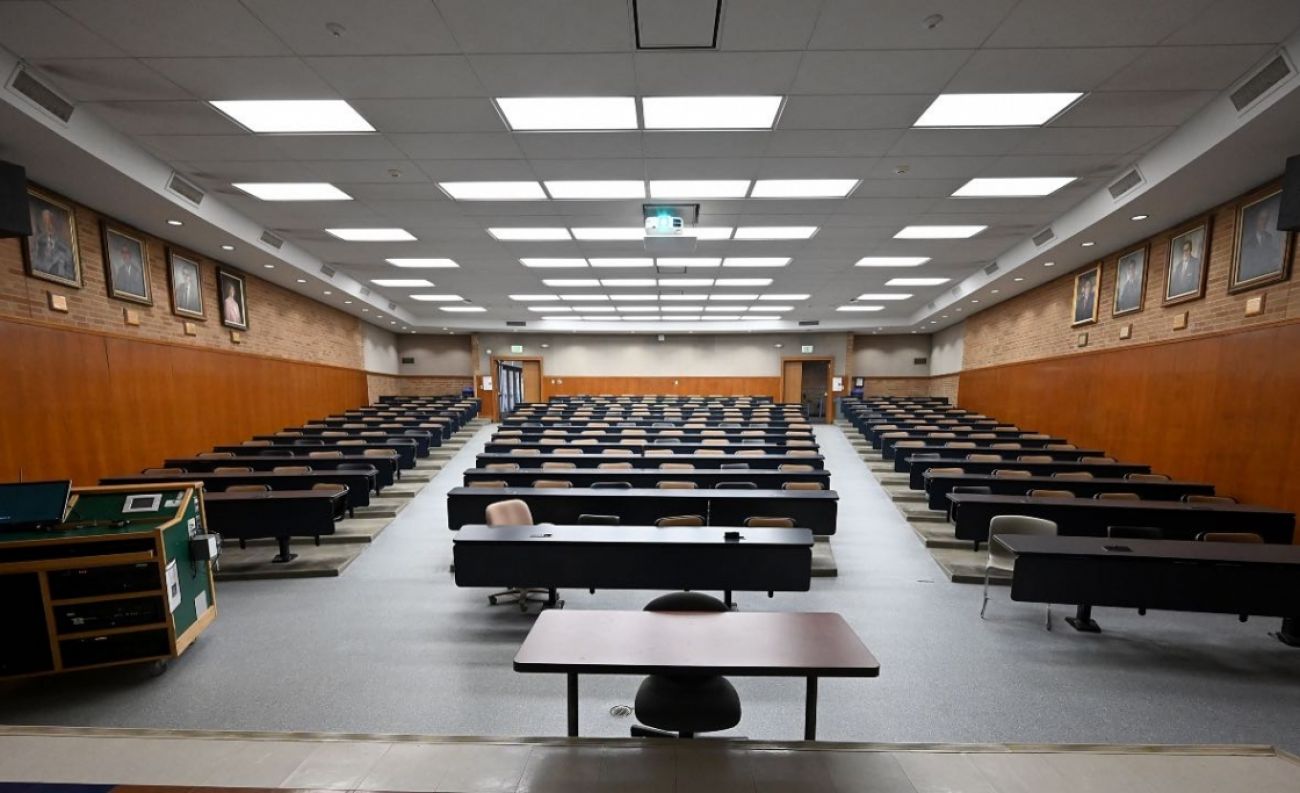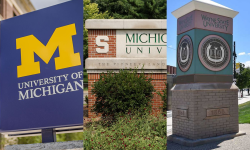Even as COVID wanes, fewer low-income students enroll in Michigan colleges

Aug. 20: Michigan college enrollment dropped amid COVID, group urges state to step in
Aug. 2: Q and A: How the pandemic stunted Michigan low-income college enrollment
For a second year in a row, fewer Michigan low-income high school graduates appear to be enrolling in college, a troubling trend experts attribute to the lingering impact of the pandemic.
Applications for the Lansing Promise, which provides financial aid to Lansing students, are down 15 percent; a similar program in rural Mason County in West Michigan has seen a 10-percent drop in applications. Both programs serve largely low-income populations, and applications to attend community college and some universities at free or reduced rates is a good indication of fall enrollment trends.
Ryan Fewins-Bliss, executive director of Michigan College Access Network, said he’s hearing similar worries among college access advocates and college admissions officers as the fall semester approaches.
Related:
- Deadline looms for thousands of Michigan residents offered free tuition
- Michigan legislation would de-emphasize SAT scores to boost college access
- U-M expands free tuition program to its Dearborn, Flint campuses
- High school/college hybrid programs growing in popularity in Michigan
“I don’t think we’ve hit the tail end of the pandemic impact yet,” he said.
The potential enrollment declines follow enrollment drops in the fall of 2020 during the pandemic. And while official enrollment figures at Michigan colleges and universities won’t be released until this fall, these early indications of enrollment declines among poor and first-generation recent high school grads are warning signs for a state that is struggling to boost the number of degrees and post-secondary certificates in the hands of adults.
“We know that college is transformative to all students, especially those from lower-income backgrounds,” Fewins-Bliss said. “Not enrolling in college affects their own economy, their family’s economy and the state economy”
Last fall — before a vaccine for COVID-19 had been developed and many colleges offered mostly online-only classes — first-year enrollment among all recent high school grads plummeted. The decline was steeper, though, for economically disadvantaged students.
According to state data, the share of low-income high school grads who enrolled in college within six months of graduating dropped from 48 percent in pre-pandemic 2019, to 39 percent in 2020. Among their wealthier classmates, the share enrolling in college dropped less steeply: from 71 to 65 percent.
The enrollment gap between poor and non-poor high school grads grew by three percentage points (23 percent in 2019, to 26 percent in 2020 during the pandemic). That’s similar to a national trend.
The decline in college enrollment between fall 2019 and fall 2020 added up to 3,318 fewer Michigan low-income college freshmen last school year, roughly the equivalent of every undergraduate student at Lake Superior State University and Kalamazoo College combined leaving campus.
And while students who delay enrollment may plan to eventually go to college, the odds are stacked against them. High school grads who don’t go to college immediately after high school are 64 percent less likely to eventually earn a bachelor’s degree than their peers who go straight to campus.
That has huge economic implications for the state, as well as individuals. A typical adult with a bachelor’s degree in the United States earns $900,000 more over their lifetime than an average adult with a high school degree.
Over time, getting more low-income students on campus helps the state expand its economy. Gov. Gretchen Whitmer has set a goal of having 60 percent of working-age adults have a college degree or post-secondary certificate by 2030. With nine years to that deadline, 49 percent of Michigan adults have a degree or certificate. That’s below the national average of 52 percent.
A lynchpin for that goal is attracting more low-income recent high school grads to Michigan campuses. COVID has hobbled that effort.
School officials and college advisors who spoke to Bridge Michigan said it appears that low-income freshman enrollment isn’t bouncing back for this fall, as many presumed it would after COVID restrictions were lifted.
For example, at the University of Michigan, the share of first-time students who were eligible for federal Pell Grants, which are given to low-income students, dropped from 20.7 percent in pre-pandemic 2019 to 16 percent in 2020. For fall 2021, despite intense efforts to attract low-income students, the share of freshmen eligible for Pell Grants at U-M is likely to remain at about 16 percent, said university spokesperson Rick Fitzgerald.
Other public universities contacted by Bridge said they didn’t have projections for the share of low-income students in their incoming freshmen classes available for release.
The share of incoming freshmen eligible for Pell Grants held steady at Adrian College and University of Detroit-Mercy, according to officials there. But Colby Cesaro, vice president of the Michigan Independent Colleges and Universities Association, said low-income freshmen enrollment has “fallen off the map” at some Michigan colleges since the pandemic struck the state, and as of yet “it’s not bounced back.”
A report released by the Whitmer administration in May warns that the impact of the pandemic on learning could suppress college enrollment even longer, suggesting “high school students from the (graduating) classes of 2020-24 may be less likely to pursue postsecondary education.”

That doesn’t surprise Rep. Sarah Anthony, D-Lansing.
For “low-income students and students of color, there are so many barriers to college,” Anthony said. “There are financial barriers, access barriers, social-emotional barriers to believing you belong,” she said. “COVID-19 has piled on to those existing barriers and made it easy for students to … not enroll.”
Lower GPA, fewer supports
College advisors agree with Anthony that the challenges of high school during the pandemic are the likely cause of the declines.
Alyssa Merten, network coordinator for the Oceana County College Access Network, said grade point averages dropped during the pandemic for many high school students.
There is no statewide data on GPA and grading policies vary from school to school. Still, Merten said her experience talking to students leads her to conclude drops in GPA as seniors led some students to believe they are not college material, or think that they won’t be admitted.
In neighboring Mason County, Jody Maloney is director of the Mason County Promise, which offers free tuition to West Shore Community College for the county’s graduating seniors. Maloney said that in one county school district, the percent of high school students flunking math classes rose dramatically last year — a failure rate school leaders and Maloney say is a side-effect of the pandemic.
“That drop in GPA, we’re assuming, is a part of the conversion to online course work,” Maloney said. “They didn’t have that (same level of) interaction with teachers.”
Merten said about 10 percent fewer high school seniors in Mason County filled out college applications this spring than in past years. More were “on the fence” about their future than normal, something she attributes to low-income and first-generation students not having the same level of exposure to information about higher education as in a normal year.
“This group of recent graduates, they missed out on a lot of opportunities, like visiting college campuses and job shadowing and college prep,” Merten said.
A similar dynamic could be the cause of a decline in high school seniors applying for the Lansing Promise, which offers tuition assistance for grads who attend Lansing Community College, or an equivalent amount of aid for those attending Michigan State University or Olivet College.
In 2020, 65 percent of Lansing School District students applied for the scholarships; this year, just 50 percent did.
One possible reason: Lansing schools were fully online all year. And while advisors texted, phoned and went door-to-door to encourage seniors to apply to college, it couldn’t take the place of the daily, face-to-face communication in a regular school year, said Lansing Promise Executive Director Justin Sheehan.
“There’s a lot to be said for in-person relationships,” Sheehan said. “A lot of the work is seeing students in school and saying, ‘Let’s walk down to the computer lab and walk through this FAFSA (the federal financial aid form).”
The Free Application for Federal Student Aid is a complicated form that requires a lot of family financial information, which can be intimidating for teens, Sheehan said. That’s particularly true for students who don’t have others in their family who have attended college and know the ropes.
During the pandemic, students had less interaction with adults who could help them apply for financial aid and fill out college applications, Sheehan said.
“It’s not because they don’t want to have a successful future,” Sheehan said. “There may not be comfort with the process.”
Removing roadblocks
The Whitmer administration report on increasing enrollment, “MI Blueprint for Comprehensive Student Recovery,” released in May, offers several recommendations for attracting more high school grads to the state’s colleges and universities. The administration is encouraging, but not requiring, local school districts to use some of their federal COVID relief funds on the recommendations, which include:
- More college advisors in high schools.
- Making the completion of the FAFSA a high school graduation requirement.
- Increasing dual enrollment and early college opportunities.
- More online college options.
- End remedial classes at community colleges, for which students don’t earn credits toward a degree.
- Automatic and guaranteed admission at community colleges.
To Rep. Anthony, part of the solution starts in communities in the state that traditionally have had lower college-going rates than the suburbs.
“We haven’t cracked the code to create a culture of learning after high school in both urban and rural communities in our state,” Anthony said. “It was already a fragile message (in those communities) before the pandemic, and the pandemic took us three steps backward.”
Community leaders need to preach the value of higher education and offer students help navigating a system that can seem foreign and intimidating, Anthony said.
Anthony recently sponsored a bill that was signed into law that allows state scholarships to be given based on scholastic achievement in high school, and not just on ACT or SAT scores. "I can't imagine trying to navigate applying for college and financial aid as a young adult in the midst of a global pandemic," Anthony said at the time of the bill passage in June.
And while efforts like her bill and Whitmer initiatives that offer free-tuition programs for adults through Futures for Frontliners and Michigan Reconnect are a good start, the state needs to find the money to help new college students with the kind of barriers that often make them drop out without a degree, such as child and elder care and car repairs, Anthony said.
“There are so many externalities to why so many people choose not to attend college,” Anthony said. “The pandemic shook us to the core and … exposed them.”
Michigan Education Watch
Michigan Education Watch is made possible by generous financial support from:
Subscribe to Michigan Health Watch
See what new members are saying about why they donated to Bridge Michigan:
- “In order for this information to be accurate and unbiased it must be underwritten by its readers, not by special interests.” - Larry S.
- “Not many other media sources report on the topics Bridge does.” - Susan B.
- “Your journalism is outstanding and rare these days.” - Mark S.
If you want to ensure the future of nonpartisan, nonprofit Michigan journalism, please become a member today. You, too, will be asked why you donated and maybe we'll feature your quote next time!





